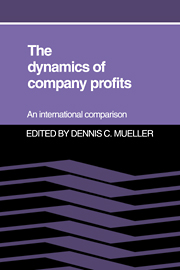Book contents
- Frontmatter
- Contents
- Preface
- Contributors
- 1 Profits and the process of competition
- 2 Modeling persistent profitability
- 3 The persistence of profits in the United States
- 4 The persistence of profits in U.S. manufacturing industries
- 5 The persistence of profitability in Canada
- 6 The persistence of corporate profits in the Federal Republic of Germany
- 7 The persistence of profits in France
- 8 The persistence of profits in Japan
- 9 The persistence of profits in the United Kingdom
- 10 The persistence of profits: international comparison
- 11 The persistence of profits in perspective
- References
- Index
2 - Modeling persistent profitability
Published online by Cambridge University Press: 03 May 2010
- Frontmatter
- Contents
- Preface
- Contributors
- 1 Profits and the process of competition
- 2 Modeling persistent profitability
- 3 The persistence of profits in the United States
- 4 The persistence of profits in U.S. manufacturing industries
- 5 The persistence of profitability in Canada
- 6 The persistence of corporate profits in the Federal Republic of Germany
- 7 The persistence of profits in France
- 8 The persistence of profits in Japan
- 9 The persistence of profits in the United Kingdom
- 10 The persistence of profits: international comparison
- 11 The persistence of profits in perspective
- References
- Index
Summary
Introduction
The structure–conduct–performance model has long attracted the attention of industrial economists interested in the empirical analysis of monopoly. The most notable characteristic of that model is that much of the theorizing underlying it is static, and virtually all of the associated empirical work has been cross-sectional in character. Standing at a slight distance to the structure–conduct–performance paradigm are evolutionary and Schumpeterian arguments. Focusing on innovation, imitation, and adaptation, they are concerned not so much with monopoly as with its persistence. Both of these alternative lines of thought are fundamentally dynamic in character, and both are concerned with analyzing competition as a process. To date, neither have generated much empirical research, much less a full-blown empirical methodology. However, as industrial economists gradually come to perceive more and more limitations in static models and cross-sectional empirical analysis, so the attractiveness of developing alternative methodologies will grow. Under the circumstances, it is natural to think that extending the empirical analysis of monopoly to examine its persistence will be placed high on the research agenda.
In this chapter, we shall make a case for extending traditional static, cross-sectional empirical models to include market dynamics. In the main, we shall examine a particularly simple type of dynamic model whose major characteristic is an autoregressive structure that emerges as the solution to a latent variables problem. Aside from any other virtues, the model does enable one to see clearly that latent variables are a major difficulty that must be faced when modeling market dynamics.
- Type
- Chapter
- Information
- The Dynamics of Company Profits , pp. 15 - 34Publisher: Cambridge University PressPrint publication year: 1990
- 35
- Cited by

